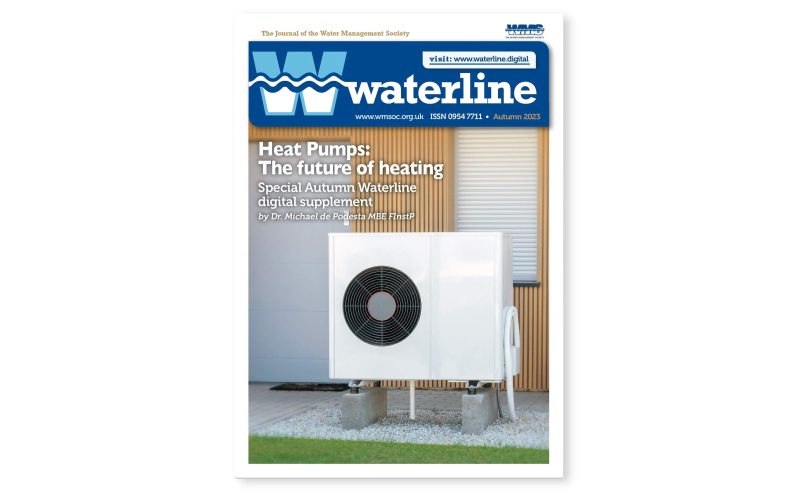As featured in Waterline Autumn 2023
Heat pumps: The future of heating
By Dr. Michael de Podesta MBE FInstP
Before retirement, Michael was a measurement specialist at the National Physical Laboratory. Since retirement he has focused on the encouraging urgent action on climate change. He is a Fellow of the Institute of Physics and in 2009 received an MBE for Services to Science.
Abstract
Despite the many benefits that humanity has obtained by burning fossil fuels, the impact of the concomitant emissions of carbon dioxide has created a grave climate crisis. Responding to the need to drastically reduce emissions of carbon dioxide presents a massive challenge to all sectors of society. But having failed to respond to our first warnings, we now need to respond rapidly. Fortunately, we have technologies available which will allow us to respond on the scale required.
In recent years, the energy landscape has been transformed, with renewable generation technologies now being the cheapest way to make electricity. Wind and solar generation, used alongside conventional nuclear generation, make it possible to produce electricity with zero proximate emissions of carbon dioxide. By electrifying as many processes as possible, we can ‘de-carbonise’ processes that previously used fossil fuels. Applying this ‘electrify everything’ principle to heating, heat pumps offer us the chance to electrify – and hence de-carbonise – our heating in both domestic and industrial settings. The energy savings available are so large that the widespread use of heat pumps is inevitable.
1. Fire and Hot Water
We still teach the Greek myth of Prometheus who stole fire from the Gods and suffered an agonising and eternal punishment as his reward. And from a cultural perspective, the persistence of this myth reflects the significance of fire in every human civilisation.
There are many reasons why control of fire is considered culturally significant, but with regard to the interests of Waterline’s readers, there are three reasons of especial significance. Historically, fire enabled us to heat our homes; to heat water for our homes; and to heat water for cooking and other processes. In the parlance of modern engineering, fire enabled space heating, and the production of both domestic hot water and process hot water.
In the modern world, fire (in boilers) is still widely used for these processes but is supplemented by electrical heating. However, since a significant fraction of electricity is still derived from burning things, there are still deep historical and technological links between fire and hot water.
But in recent years, the seeds of renewable energy technologies have grown into a nascent energy transformation. This represents a technological revolution of comparable significance to the first industrial revolution. In this transformation new technologies will replace old technologies not because they are ‘greener’, or represent a ‘more moral choice’, but rather because they are simply cheaper. Electricity generated using solar photovoltaic panels and wind turbines is the cheapest electricity that there has ever been. And eventually, both industrial and domestic habits of consumption will inevitably adapt to exploit the new patterns of availability of this cheaper resource.
So, as I write in 2023, not only is it now possible to heat water electrically without burning any fuel at all, but these renewable technologies have also become the cheapest way to heat water. And accompanying progress in these renewable generation technologies, heat pumps offer a way to dramatically reduce the cost of heating water even further. Depending on the temperature through which water is to be heated, the cost could fall by a factor somewhere between 2 and 5. So even as immersion heaters offer 100% efficient conversion of electrical energy into thermal energy, heat pumps offer efficiencies between 200% and 500%.
In this article I will look at what heat pumps do and how they do it (Section 3), and then look at some details of their design (Section 4). I will then (Section 5) describe a typical domestic installation of a heat pump and its role in space heating and the preparation of domestic hot water. I will then (Section 6) discuss the costs of a domestic heat pump installation. Finally (Section 7), I will briefly outline applications of heat pumps for process heating in different industrial sectors.
But before embarking on this journey, I hope you will please allow me to explain briefly why this matters as much as it does. In every audience I have addressed over recent years I have found that there are people who feel – despite the indisputable facts of the warming globe – that our climate crisis is a hoax of some sort and that – to quote our former Prime Minister – renewable technologies are just ‘green crap’. This section is addressed to those people reading this who choose to disbelieve the overwhelming evidence of the harmful effects of carbon dioxide emissions and who apply to themselves the label: ‘climate sceptic’.












